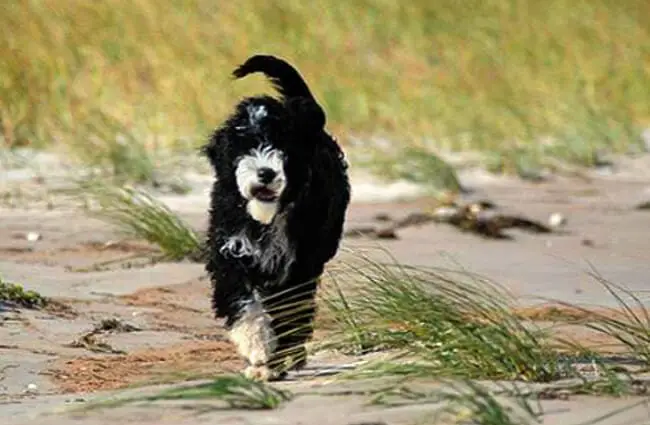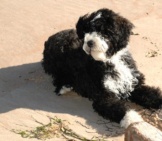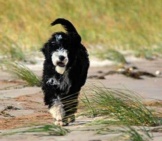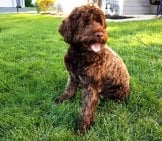The Portuguese Water Dog (“PWD”) is a spectacular athlete and spirited companion. These are swimmers through and through, meant to perform an array of tasks for the fishermen in Portugal.
Today, they’re more often social family pets or jogging partners for athletes. Plus, their low shed coat is perfect for people with allergies. Read on to learn more about the Portuguese Water Dog.
Description of the Portuguese Water Dog
These dogs have some curly locks. They’re known for their low shed coats that blanket the dogs in anything from tight ringlets to loose waves. PWDs can be any of these colors: black, white, various shades of brown, or black or brown with white markings
Overall, PWDs are friendly, bold, and steady. These dogs are medium-sized, yet sturdy. Although it’s difficult to spot the muscle under all that hair, it’s there! These dogs are lean and strong.
Life Expectancy and Size
These dogs are a convenient, medium size. They may stand between 17 and 23 inches tall and weigh 35 to 60 pounds.
The Portuguese Water Dog does not have many breed specific health concerns. However, their life expectancy is still relatively short for a medium sized dog. They should live between 11 and 13 years.
Protective Ability
Like many alert and active breeds, the Portuguese makes a passable watchdog. However, they’re quite friendly and don’t actually serve as a deterrent. Their lovely personalities make these dogs much better companions than guards.
Training
This breed is smart and generally easy to train for a competent owner. They enjoy learning new things and are generally enthusiastic, sometimes to the point of exuberance. Treat-based training is all that’s necessary for these willing learners.
To keep their energy in check, keep training sessions short and to the point. Commands should be clear and positive reinforcement immediate. Show them why it is in their best interest to listen.
Energy Level
Breeders bred these dogs to be capable hunters. Today they remain alert and always ready for action. At minimum, they need ample chances to stretch their legs. Ideally, they will also have a chance to exercise their minds. Nosework (finding hidden treats or objects by scent) is a particularly good way to exercise this breed’s active mind.
PWDs will tell you if they’re not receiving enough entertainment. Most become destructive when bored; they’ll find their own opportunities for fun, which might not match up with their owners’ preferences.
What Living with a Portuguese Water Dog is Like
The Portuguese Water Dog is an active companion, perfect for families that like to include their pets in the fun. These dogs need to be around their people, or they will quickly become sad. They’re not meant to sit around alone all day.
These dogs are particularly brilliant swimmers. They love life around the water, although they can also channel their energy into other athletic pursuits.
Unfortunately, these dogs don’t have the longest life expectancy. However, they are generally healthy pets.
Care of the Portuguese Water Dog
These hardy dogs are up for anything. If you’re an active person and willing to include the Portie in your day-to-day activities, they’re a breeze to care for.
Environmental Needs
Porties have had to deal with everything from the summer heat of Portugal to the icy waters of Iceland. These seafaring dogs could handle it all, especially the water. They’re not fussy. Of course, always provide adequate shade and water while these dogs are outside.
Exercise Needs
This breed is similar to many other former hunting or fishing dogs. Their breeding ensures they’ll be active, and need plenty of exercise. In addition, they prefer to have a job to do, but can usually adjust to directed activities with their people.
At minimum, the Portuguese Water Dog needs one or two long daily walks. Play sessions in the yard can be a good way to get them thinking. Many enjoy retrieving, especially when water is involved.
For athletic owners, hikes, jogs, and bike rides can be a great way to keep the Portie active. Doggie sports like obedience or tracking are perfect outlets for their keen minds.
Shedding and Grooming
The Portuguese Water Dog is one of the few breeds dubbed to be hypoallergenic. Although this title may be misleading, they are a good choice for allergy sufferers. Their coat is low shed and excess hair and dander remains seated in the tight curls. You can remove this by daily brushing, so debris doesn’t end up in the air and become irritating.
These dogs only need the occasional bath, as well as a periodic clipping. Most people stick with a short, uniform cut that leaves only a couple inches of curls. Some leave a bit of fluff on the tail while others shave their rump and muzzle in a lion-like style.
Ideal Home Environment
This breed is great for suburban or rural families that have plenty of access to the outdoors. They can survive in cities too, but cannot simply walk around the block for exercise.
PWDs are a bit too rambunctious with small children, but are loving with older members of the family. They will particularly enjoy joining athletes on their daily pursuits.
These dogs will do best in a home where they have plenty of social interaction. They don’t like to be alone and can become sad. Most individuals do well with other pets, especially if they’re raised together. Earl socialization is important, as it is with all dogs.
Health Concerns
This breed does not have many specific concerns. Eye and hip problems may develop, especially later in life. The chances of inherited issues are much smaller when using a responsible breeder.
Because of their long hair and ears, PWDs a prone to ear infection. Check and clean these often.
Behavior Problems
When excited or under-worked, the Portuguese Water Dog can be a bull in a china shop. They are often exuberant, especially when they do not receive much exercise. Boredom also often precipitates destructive behaviors like barking or digging. Keep these dogs entertained and they will make great family pets.


























![Red Angus Closeup of a beautiful Red Angus cowPhoto by: U.S. Department of Agriculture [pubic domain]https://creativecommons.org/licenses/by/2.0/](https://animals.net/wp-content/uploads/2020/03/Red-Angus-4-100x75.jpg)

